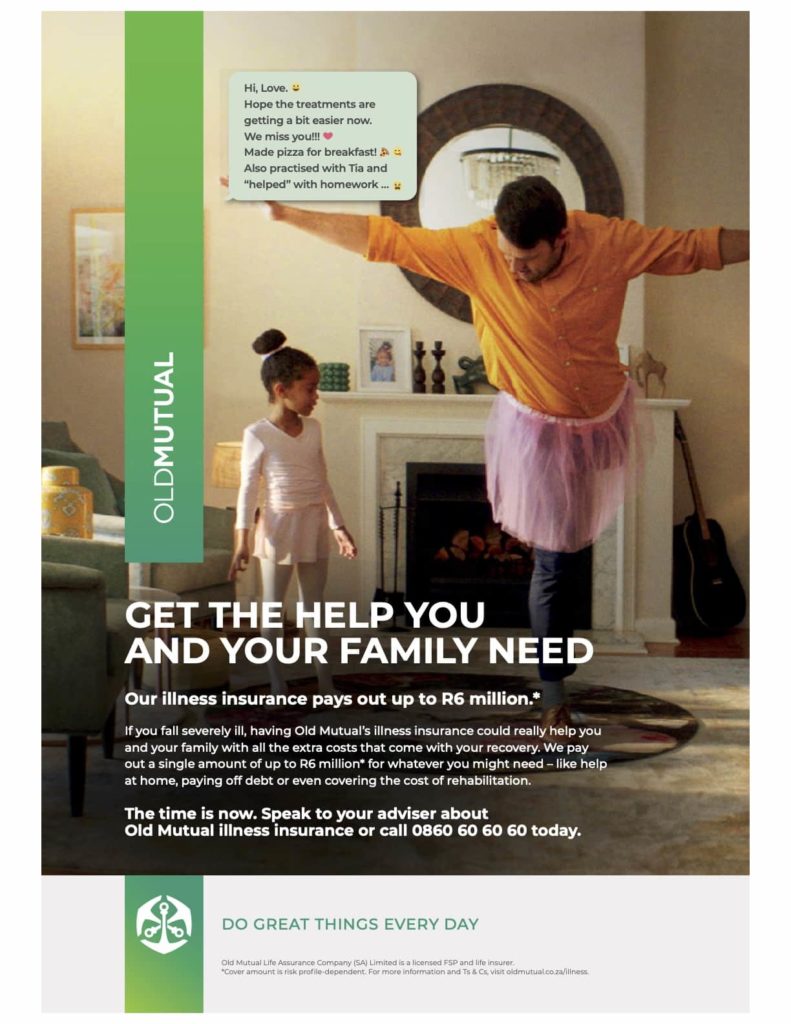
Jacqui Nel, Business Unit Head of Healthcare at Aon South Africa.
The far-reaching implications of ill health
Few people consider the far-reaching implications of a health crisis on every facet of their lifestyle.
The devastating effect of a serious health crisis such as cancer, a stroke or heart attack, COVID-19 or even an accident typically extends far beyond the physical consequences of such an event, with significant implications for your financial and emotional wellbeing too, and even your ability to work and earn an income.
Navigating the implications of a potential health crisis requires a holistic approach that takes into account not only the cost of the healthcare treatment both in and out of hospital, but also looks at aspects such as income protection if you’re unable to work, disability (which could be temporary or permanent) and any lifestyle changes you may have to make as a result. The reality is that while a healthcare financial plan that includes medical scheme benefits to cover your medical costs is crucial, a much wider safety net is needed to protect you if you’re unable to work and earn an income, and the potential for temporary or even permanent disability.
Aon offers the following aspects to consider when navigating the financial implications of a possible future critical illness diagnosis:
- Maintain your access to quality private healthcare
Given the major financial challenges facing consumer households as a result of various lockdowns, the affordability of maintaining medical scheme cover is another hurdle facing medical scheme members.
In Aon’s 2021 Global Medical Trends Rate Report, it was found that South Africa’s medical trend rate is expected to remain stable with percentage increases in medical plan costs anticipated for 2022 at 5.% to 6.5%.
As long as the COVID-19 pandemic continues it is difficult to predict what future medical scheme contribution increases may be. 2020 has shown a decrease in claims ratios during the ongoing pandemic. However, claims are steadily increasing back to 2019 trends and in certain instances increasing above 2019 trends. Many uncertainties prevail, such as the impact of mental health, the delay of preventative care and any COVID-19 side-effects that are yet to be determined. Medical schemes will have to evaluate its immediate circumstances and take future risks into consideration to determine its medical scheme contribution increases.
As financial pressures remain, many medical scheme members are looking to change and downgrade their benefit options in a bid to save money, but still retain access to quality private healthcare in a crisis.
Making the right decisions about the options selected within a medical scheme starts by understanding what benefits will be available and the affordability of the premium attached to these benefits. Benefits that are not covered will have to come out of your pocket, which needs to factor into your decision. The Medical Scheme Act currently protects members within the realm of Prescribed Minimum Benefits (PMBs), which enforces cover for 270 diagnosis and treatments of a defined list of chronic conditions and emergency care, assuring members of this cover, which now includes COVID-19 diagnosis, treatment and care.
The only precaution to take is to confirm whether the cover falls in the private or public-sector environment. Once that aspect is confirmed, a member can drill down to the day-to-day care offered in a medical scheme option and the subsequent affordability of it. Make sure you do this planning with the guidance and advice of a professional and qualified healthcare broker.
- Get Gap Cover
Most medical schemes have deductibles and co-payments and many members are left out of pocket when hospitalised due to shortfalls on what specialist doctors charge which is usually significantly higher than the rate that medical schemes reimburse. This gap becomes more pronounced when a patient is faced with a critical illness. Gap insurance can step in and reduce the financial impact with a medical scheme that may impose a co-payment or an annual limit on oncology. Various gap cover options are available in the market, including options that provide additional cover for critical illness. These limits are low and therefore increasing this cover in your personal life insurance cover may be required
- Get back to regular health checks
A major trend brought about by the pandemic is that of deferred treatments and routine checks for fear of exposure to COVID-19 infection, which will have far-reaching health impacts in the long run. The longer symptoms are ignored, and the later a patient is diagnosed with a serious illness or condition, the more complex the health implications become, in addition to treatments becoming more costly and possibly more protracted. In the case of critical illnesses such as cancer, a delay in diagnosis and commencement of treatment greatly impacts prognosis and survival rates. The pandemic will continue for months if not years, thus it’s essential that preventative annual health checks are routinely done.
- Critical Illness Cover
While your medical scheme benefit may cover you for the actual medical treatment in a health crisis, the reality is that it may not cover you for everything, such as out-of-hospital treatment and especially the domino impact of ill health on your finances. In fact, critical illness cover has little to do with the cost of treatment but more with the loss of income – which is where it differs markedly from medical aid which is based on the cost of treatment. For example:
- If your medical scheme does not cover biologicals for cancer treatment, the lump sum received from your critical illness cover places you in a position to afford this if needed.
- Regardless of your health, life goes on. Additional expenses such as hiring an au pair to take care of your children while you are unable may be necessary. You may require home nursing or a step-down facility to get you back on your feet, which may not be covered by your medical scheme. Or you may run out of sick leave before you’re fully recovered. Your critical illness cover will help bridge the cost of these lifestyle changes.
Disability cover
Most people are shocked to learn that critical illnesses such as cancer, heart attack, stroke and diabetes – and not accidents – cause the majority of partial or permanent disabilities. Disability cover is about compensating for the future loss of income and costs associated with being disabled as a result of a critical illness or accident.
A permanent disability prevents a person from working again. This is where disability insurance provides a lump sum or monthly income benefit should you become permanently disabled and as a result, unable to work and earn an income.
Should you become partially disabled, you would likely need to take a lower-paid position or work reduced hours. Managed disability income insurance provides for pro-active health management and rehabilitation programmes to assist you to return to work in a reduced capacity but still earn an income. From an employer’s perspective, this leads to a saving in training costs and results in continued productivity. Early intervention with a rehabilitation programme significantly increases the chance of recovery and ability to return to work.
A critical illness diagnosis has very far-reaching implications for your lifestyle that extend well beyond the costs of medical treatment. While you are sick or in recovery, there are very few people who don’t need to work to pay the bills – which won’t stop arriving because you’re sick or injured to the point that you are unable to work and function normally.
The interplay between medical scheme benefits and gap cover, to critical illness insurance, disability and income protection requires careful planning and the guidance of an expert broker to assess your needs as part of a holistic financial planning portfolio.


